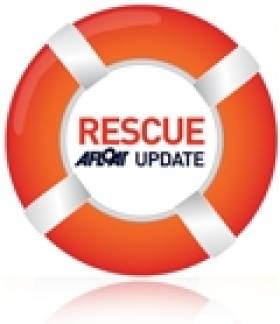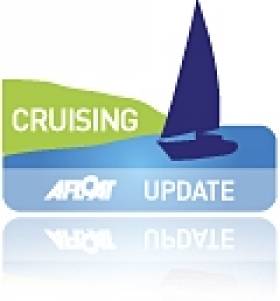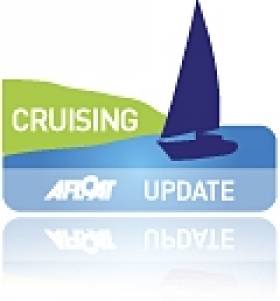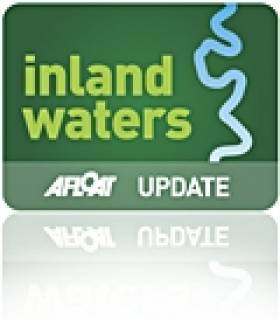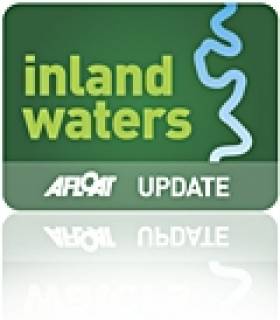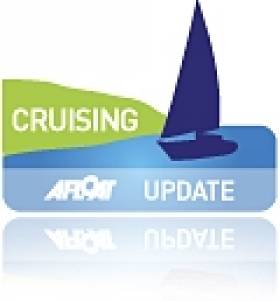Displaying items by tag: Cruising
Two Rescued from Cruiser on 'Enraged' Lough Derg
#RESCUE - The Irish Times reports that two people were rescued from a cruiser that ran aground in an "enraged" Lough Derg on Sunday afternoon.
Eyewitnesses on the shore at Terryglass in Co Tipperary raised the alarm after spotting the duo in distress when their boat lost power amid force 8 gales.
The Lough Derg RNLI lifeboat was dispatched but stood down on news that both persons on board the cruiser had been taken to shore by another boat in the area responding to a radio alert by the Irish Coast Guard.
Is 'Adventure Sailing' a New Tack for Dinghy Sailors?
#DINGHY SAILING – It is a common complaint that dinghy sailing is in decline. Veteran keel-boat sailors wax nostalgic about those long-gone days when huge fleets turned out for the major dinghy class championships writes our correspondent Magheramore.
Yet there were 292 entries for the recent Mitsubishi Youth National Championships, the winter Laser racing in Howth is flourishing as are the DMYC Frostbites.
However, a closer look at the dinghy park at the Youth Nationals did indicate where a problem may lie. All the boats were recent, the sails were new, many competitors were professionally coached or accompanied by their parents in a comfortable RIB. One would expect this, the young sailors (and their parents) want to do well. The impression given is that dinghy sailing is an expensive pastime requiring dedication, athletic prowess and intensive training. This perception may erect a psychological barrier to entry to the sport. Apprentice sailors, young in years or young of heart, may decide that other forms of messing about in boats are more accessible: crewing on big boats, angling, kayaking or rowing.
Racing is only one aspect of dinghy sailing. If racing is compared to track athletics, how about a nautical stroll in the park or some nautical hill walking! Dinghy cruising has been defined as sailing a dinghy for any other reason than racing. That may be too sweeping a generalisation. Perhaps a better way of putting it would be that dinghy cruising is all about going somewhere in a small boat.
There is an extreme branch of the sport: the late Frank Dye's Wayfarer crossings to Norway and to Iceland; Webb Chiles circumnavigation in a Drascombe Lugger or the two Royal Marine officer's expedition through the North West Passage 17.5ft Norseboat. Oceanic openboat sailing has it's founding fathers: Shackleton and Crean, Captain Bligh and our own St. Brendan.
But just as not all hill walkers attempt to scale Everest, or even Carrantuohill, there are many who enjoy a more gentle sail. I have often admired a venerable Mirror, usually sailing without a jib, cruising round Dun Laoghaire harbour. If you look carefully there are Wayfarers, Drascombes and others tucked away at the top of many a sheltered beach or creek, waiting a family picnic, an evening sail or a trip out to catch a mackerel or two for breakfast. In parts of Donegal, and possibly elsewhere, the humble Mirror seems to have replaced the more traditional curragh. Used as a tender, a fishing boat, a swimming platform or for short sail the Mirror can be bought cheaply, launched and recovered single-handed and can be sailed (with one or two sails), rowed, paddled, sculled or even (shudder) motored.

A UK dinghy visitor Jady Lane moored in Athlone. Photo: Aidan de la Mare
Successful dinghy cruising does not depend on a new boat. Indeed one might be happier when beaching on a stony beach if the gel coat already has a scratch or two. Boats for such sailing are a personal and often somewhat idiosyncratic choice. Who would have thought that a Finn could be converted into practical cruising yawl? Or that a Mirror dinghy could cruise from the Severn to the Black Sea, with the skipper sleeping "comfortably" aboard. Stability is the one essential design feature, indeed some dinghy cruisers maintain that the Wayfarer is far too tippy a boat.
Many dinghy cruising sailors never progress beyond pottering or day sailing. A lifetime is too short to explore the nooks and crannies of the Irish coast line, not too mention the many loughs. When camping or self-catering beside the water, having a dinghy ready to launch greatly enriches the holiday. Yet, inevitably, there comes a day when the the skipper wants to sail out to that distant island, or around the point, too far to return the same day. At this point the huge advantage of exploring in a dinghy rather than on foot becomes obvious. Even in the smallest dinghy room can be found for a tent, foam mattress, sleeping bag, stove, provisions and, luxury, a bottle of wine and a corkscrew! The boat does the carrying rather than your back. There are many places round the coast where a tent can be pitched discreetly. The sea-kayaking fraternity have been doing this for years.
Most cruising sailors then realise that it is in fact more convenient to sleep on board. This is no less comfortable than sleeping in the kind of bivouac tents used by back-packers and cyclists. There is also one great advantage, by choosing an appropriate anchorage one can escape the midges!
Dinghy cruising is not a structured activity. Most cruising sailors are fiercely independent, and most stay well away from yacht clubs. Yet the Dinghy Cruising Association in the UK has 468 paying members (some of them in Ireland), with a further 29 joining in the last 3 months. Races are not part of their programme. Rallies can be low key – meet for lunch, or an overnight stay at specified spot (often conveniently situated within strolling distance of a welcoming pub). There is a developing trend to organise Raids – cruises in company, sometimes with an element of competition. An annual Raid is organised through the Great Glen in Scotland. Others are held in the Baltic. Above all, the traditional boat revival in France has been accompanied by explosion in events for "voile-aviron" (sail and oar). Especially if you have a wooden boat, you will be welcome at the big traditional boat festivals such as those held in Brest and Douarnenez. Perhaps one day there will be a Raid Ireland?
In short, pottering or cruising in small open boats is an exciting adventure open to all. The seamanship skills learnt taking a boat from Bray up to Dalkey Island, or from Dromineer to Mountshannon can be of much use to a budding sailor as learning to roll tack a Laser. In fact, dinghy cruising, probably renamed "adventure sailing", opens a whole new world for sailing schools and club training. Transition year groups or the local Scout troop would certainly be interested. As more extreme outdoor pursuits, from fell-running to bog-snorkelling, gain new participants, there is surely room for dinghy cruising – Magheramore
Wtih thanks to the Dinghy Cruising Association for photography in this article
Home Made Boat Wins Top Award
#Irish Cruising Club Annual Awards – A home-made steel cutter well on the way to completing a three year global circumnavigation has been awarded the Irish Cruising Club's top trophy, the Faulkner Cup, for the second year in a row. Fergus and Kay Quinlan built their 38ft van de Stadt-designed Caribbean 12 Pylades themselves, launching her in 1997, and after some impressive cruises, departed their home port of Kinvara on a world voyage two years ago.
Fergus is an architect. As he remarked before leaving, things were looking rather quiet on work the work front in the architectural area as the financial crisis and economic recession bit deep in Ireland. So it seemed a good idea to go sailing. He brings an architect's sharp eye and social curiosity to his accounts of the cruise, and the first stage to Tahiti from Kinvara garnered them the Faulkner Cup for 2010.
Now the second stage from French Polynesia across wide ocean and among many islands to Darwin in northern Australia has secured the award for 2011. That part of the cruise was completed last Autumn, and their boat Pylades has long since sailed on to fetch up in South Africa, celebrating Christmas in Cape Town, so it's not all tough seafaring.
They departed Cape Town late January and are now well in to the Atlantic, headed for Brazil via St Helena. Quite soon they will have completed the circumnavigation north of Brazil, and by summer's end Pylades should be home in Kinvara, and well in contention for the Faulkner Cup three years in a row.
Such an achievement is not without precedent – back in the 1920s, before the Irish Cruising Club existed, Conor O'Brien of Foynes won the Royal Cruising Club's Challenge Cup three years in a row for his pioneering voyage round the world south of the great capes in the 40ft ketch Saoirse, which he'd designed himself - she was built in Baltimore in 1921-22.
Like Fergus Quinlan, Conor O'Brien was an architect - you can see his work in St Mary's Cathedral in Limerick. Perhaps it's not beyond coincidence that the Irish Cruising Club's Strangford Cup for an alternative best cruise has also gone to an architect, Stephen Hyde of Cork, who has already completed his circumnavigation with his Oyster 56 A Lady. But has been enjoying the sailing so much that he has prolonged the venture with a detailed cruise up the east coast of America to Maine where, with 36,395 miles already logged, their cruising in 2011 was completed.
The awards were adjudicated by former ICC Commodore Peter Ronaldson of Belfast Lough, and the other trophies found new homes as follows:
Round Ireland Cup: The awarded cruise is expected to add to the knowledge of Ireland's coast for the Irish Cruising Club's published Sailing Directions, and the 27-day circuit by Donal Walsh of Dungarvan with his Moody 31 Lady Kate did this very successfully, with stopovers in some seldom-visited places.
Rockabill Trophy for Seamanship: To Norman Kean of Courtmacsherry, who is Honorary Editor of the ICC Directions. In his cruise he visited more than 125 anchorages on Ireland's west coast, clarifying the reality or otherwise of information. Among other things, he and his shipmates discovered a dangerously low power line at Ballyshannon in Donegal by sizzling into it, and they also showed that the Joyce Sound Pass through the tangle of rocks which tumble out towards Slyne Head in Connemara is mislocated on the charts by quite a few metres – if you relied totally on GPS, you'd be on the bricks.
Wybrants Cup, for best cruise in Scottish waters: To Dick Lovegrove of Dun Laoghaire for his lively jaunt with the Sigma 33 Rupert through some very Scottish weather.
Fingal Cup, for log the adjudicator most enjoyed: Maire Breathnach of Dungarvan and Lymington for her account of the gaff ketch Young Larry's cruise through the islands of Alaska and western Canada.
Glengarriff Trophy, best cruise in Irish waters, and Wild Goose Cup for log of literary merit: Mick Delap for his often poetic account of the 24ft gaff cutter North Star's cruise from Valentia Island to the Clyde in Scotland, visiting as many Irish islands as possible en route.
Perry Greer Bowl, best cruise by first time contributor to ICC Annual: David Jones of Howth for informative account of detailed venture in several stages from Howth towards the Mediterranean in the Oceanis 43 Tidal Dancer, going via Isles of Scilly, southwest England, Channel Islands, all of Brittany, Ile de Re , northwest Spain, and northern Portugal with winter layup ashore at Povoa de Varzim, a useful new marina/boatyard 20 miles north of Porto.
Marie Trophy, for best cruise in boat less than 30ft LOA: Sean McCormick of Howth (for third year in a row), extensive cruise in south Brittany with First 30 Marie Clair II.
The John B Kearney Cup, an open award for outstanding contribution to Irish sailing, went to Jerry Smith of Baltimore, skipper of the dive-boat Wave Chieftain which completed the remarkable rescue of all the crew of the capsized Rambler 100 at the Fastnet Rock by finding the five crew members in the sea who had become detached from the rest of the group, and were drifting lost as night came on.
Gull Salver, open award for best-placed Irish boat in Fastnet Race: to Bruce Douglas of Carrickergus, skipper of the J/133 Spirit of Jacana.
Commodore David Tucker of Kinsale reviewed a remarkable year at the crowded AGM of the Irish Cruising Club, a year in which the members' boats were seen in locations seldom if at all visited before. One of these was very near home. In August 2011, one of the club's more entertaining gatherings was a rally by the East Coast Members in the Grand Canal Basin in the heart of Dublin, where they berthed beside the avant garde Liebeskind-designed Grand Canal Theatre. The sense of achievement of the re-vamped location was matched by several of the ICC boats in port, which included Pat and Olivia Murphy's world-girdling Aldebaran, and Brian and Anne Craig's Concerto, which has voyaged to Iceland.
ISAF Posts Review of Development Symposium
#DEVELOPMENT - The International Sailing Federation's (ISAF) inaugural Development Symposium at Howth Yacht Club recently "promised much in the way of passionate discussion", according to its review of the two-day event.
Presentations were given by Tony Wright, training manager of the Irish Sailing Association, who outlined the ISA's national programme that keeps the focus of the sailor "at the centre of all that they do"; and Simon Jinks who walked through his new Guide to Offshore Personal Safety for Cruising and Racing.
Meanwhile, World Youth Sailing Trust coach Hugh Styles spoke on the subject of cohesive training programmes adding value to international events and leaving a legacy for host nations and teams alike.
Participants from the federation's member nations kept an 'ideas bank' which listed development ideas for future consideration, including a proposal for a development forum for sailing coaches, and using the model of the European Qualifications Framework as a reference for coaching competencies.
New Zealand, South Africa, Iceland and Turkey were also suggested as locations for future symposiums.
For more see the full review of the Development Symposium at the ISAF website HERE.
Irish Coast Sailing Directions Digital Trial
#CRUISING – If you plan to cruise to, along, or around, the Irish Coast the essential pilotage publications are the Irish Cruising Club's acclaimed Sailing Directions (SDs), published in two volumes.
As well as comprehensive and accurate coverage these SDs offer the best update and corrections service in the business, downloadable free from the ICC website, and always up to date. This is a great boost to a skipper's confidence – good information means safe navigation!
This summer the club will be pioneering digital SDs in both web format and as downloadable PDF pages, perfect for PC or iPad. The test area will be Galway Bay and the Aran Islands and these directions will be available free to competitors, visitors and all interested sailors before and during the Volvo Race finish from the ICC website – www.irishcruisingclub.com – where full details of the Sailing Directions to East & North Coasts, and South & West Coasts, can also be found.
ICC SDs are available from chandlers and booksellers, are distributed in Great Britain and the rest of the world by Imray, and in Ireland by Todd Chart Services.
East and North Coasts Directions ISBN 978 0 9558 199 1 9; South and West Coasts Directions ISBN 978 0 9558 199 2 6.
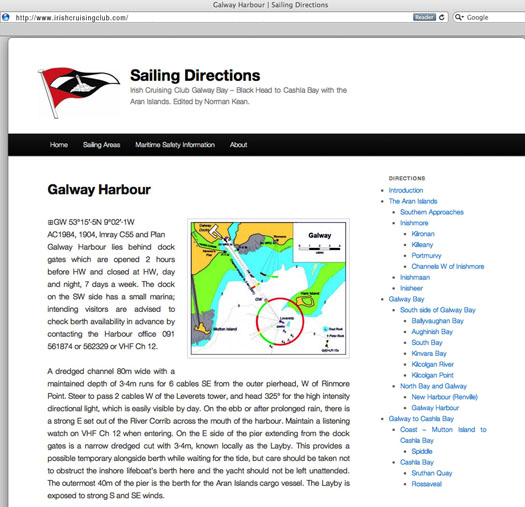
River Barrow Has Potential for Tourism
#INLAND WATERWAYS - A new study on the River Barrow and its environs recommends the development of "activity hubs, tourist trails and new angling and boat facilities", The Irish Times reports.
Waterways Ireland and Fáilte Ireland commissioned the Barrow Corridor Recreational, Tourism and Commercial Identification Survey to find ways to exploit the area's "undeveloped potential" for tourism.
The survey covered the river itself as well as its estuary and the Barrow branch of the Grand Canal. Its findings pointed to a number of areas where development is already being actioned, such as in boating and cruising, nature and wildlife, and angling.
Environment Minister Phil Hogan, who launched the study in Carlow yesterday, hailed the co-operation of the agencies and county councils involved.
The Irish Times has more on the story HERE.
Howth Yacht Club to Host First 'Family Cruising Week'
#CRUISING – Cruising enthusiasts throughout Ireland, Britain, Europe and even further afield are being invited by Howth Yacht Club to participate in the inaugural Fingal International Family Cruising Festival between July 7th and 15th for what is the first event of its kind ever staged.
The Festival – Family Cruising Week, for short – has been designed to encourage sailors from far and wide to sail to Howth, berth in the marina for the week (up to 100% discounts will apply depending on distance travelled to get to Howth) and engage in a varied programme of activities, tours, talks and entertainment in the Howth area as well as tourist attractions in Dublin city and surrounding counties.
Unlike other cruising weeks (which entail participants sailing from location to location), the objective of the FIFCF is to attract boat-owners to sail to Howth while non-sailing family members can join them (travelling by road, ferry or air) to stay on their boats or in local accommodation.
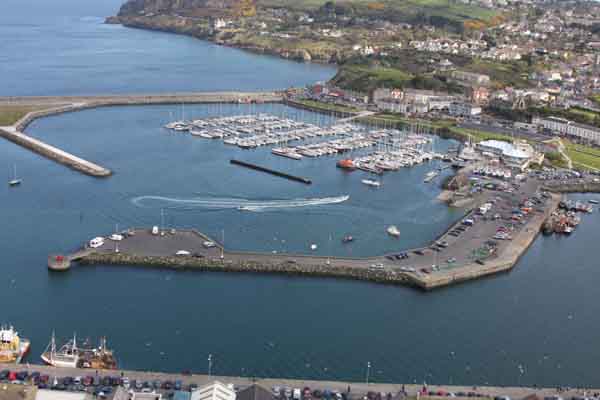
Howth harbour is the venue for a new cruising event this Summer
The programme for the week will include scenic and heritage tours of the area, golf/tennis/hillwalking, competitions, dinners and entertainment, and activities for children. The event, which has the support of Failte Ireland and Fingal Tourism, is expected to generate in the region of 4,000 bed nights as well as benefiting local businesses. Visitors will sample local restaurants and pubs and will also require groceries, general supplies, marine services, etc.
The unique event will conclude on Sunday 15th July when participants will be invited to take part in the second 'Boat of Hope Day' organised by Howth YC in conjunction with the Variety Club of Ireland. In 2010, boat-owners in Howth and neighbouring clubs took 100 disadvantaged children, their parents, siblings and carers on the water and then entertained them with onshore activities.
An organising committee, headed by noted cruising expert Pat Murphy, is currently working on the various elements of the Festival and, in particular, marketing it overseas.
See www.hyc.ie/familycruisingweek
Further information from: Pat Murphy, Event Chairman – 087-253 1341 or [email protected]
New Mobile Guide to Lough Derg Trails
#INLAND WATERWAYS - A new mobile app that guides visitors around the trails of Lough Derg has gone live, the Clare Champion reports.
More than 20 trails are included in the app, from walking to cycling, driving, cruising and canoeing.
The app - developed in partnership between Shannon Development and US firm EveryTrail - uses Google Maps and the GPS system in smartphones to pinpoint trails near the user's location.
Users can download route descriptions, images and notes, get directions to the starting point and follow the the pre-plotted course.
The Lough Derg Trails app is available for iPhone and Android devices.
The Clare Champion has more on the story HERE.
American Blue Water Medal Goes to Matzen and Ericson
#CRUISING – The Cruising Club of America (CCA) has awarded its esteemed 2011 Blue Water Medal to Thies Matzen and Kicki Ericson for a commendable 24 years and 135,000 miles of sailing the oceans of the world with a focus in the high latitudes of the Southern Ocean. The first Blue Water Medal was awarded in 1923; and is given to "the most meritous example of seamanship." Its recipient is selected from among amateurs of all the nations." The medal will be presented by Commodore Daniel P. Dyer, III at the annual Awards Dinner on March 2, 2012 at New York Yacht Club in Manhattan.
Matzen was born in Germany in 1956 and grew up to be a wooden boat builder. In 1981,Matzen purchased Wanderer III, a 30 foot wooden sloop, built in 1952 for Eric and Susan Hiscock who made two circumnavigations with it and received the Blue Water Medal in 1955.Matzen sailed Wanderer III to Scandinavia where he cruised extensively, including to the Lofoten Islands (Norway), and then crossed the Atlantic Ocean. In 1989, while sailing in the Caribbean, he met Swedish-born (1964) Ericson, and the two have lived on Wanderer III ever since. After leaving the Caribbean, the duo sailed through the Panama Canal and into the Pacific Ocean where they spent seven years traveling from site to site. After that, Ericson and Matzen sailed to Indonesia, explored the Indian Ocean, and sailed around the Cape of Good Hope (South Africa).
From 1997 to 1999, Matzen and Ericson did two circuits of the South Atlantic, starting in Cape Town (South Africa) and visiting Argentina, The Falkland Islands, and South Georgia before heading back to Cape Town (South Africa) and South America, where they rounded Cape Horn before returning to the Pacific. The couple's last twelve years have been comprised of exploring sites in the Southern Ocean, including Tasmania, The Auckland Islands, Antarctica and the Falkland Islands. Recently the two spent 26 months in South Georgia. Currently, Matzen and Ericson are in Brazil and plan to do some work on Wanderer III, which has been kept in its original condition with no electronics onboard except a VHF radio and handheld GPS (added in 2007). The vessel has a 16 horsepower diesel engine and the hull, rigging and gear have been self-maintained using traditional methods.
In addition to presenting its Blue Water Medal, the CCA will present the following 2011 Awards:
Far Horizons Award awarded to Brian and Mary Alice O'Neill (Bainbridge Island, WA) for an admirable 25-month cruise circumnavigating the Pacific Rim, North Pacific Ocean on their 44-foot Robert Perry Designed sloop Shibui. En route the two delivered school supplies to those in need and toured WWII sites.
Richard S. Nye Trophy awarded to Gary Jobson (Annapolis, Md.) for sharing with the club his meritorious service, racing, and statesmanship in the affairs of international yachting.
Rod Stephens Trophy awarded to Bob Arzbaecher (Milwaukee, Wisc.) and the crew of the Beneteau 40.7 Sociable for their dramatic rescue of the crew of the Kiwi 35 WingNuts during the Chicago Yacht Club's 103rd Race to Mackinac held this past July.
Corks Pop for Cruising's 4,000th Member
#CRUISING – On the first day of the London Boat Show the Cruising Association's Patron, Sir Robin Knox-Johnston, welcomed Eric Roberts as the 4,000th member of the Association.
Eric, 57, lives in Shenfield, Essex, and was introduced to the Cruising Association by his sister Eileen and her husband Chris Wintrell who bought Michael Buerk's boat 'Airwaves of London'. "They are quite active CA members and recommended it to me enthusiastically" said Eric. Although Eric has sailed since the age of eight, he is awaiting delivery of his first boat, a Beneteau Oceanis 45, which is due to be launched in March. He plans to sail the new yacht through the Mediterranean from France to Gocek in Turkey. After a year or two, Eric's dream, once he has built up enough experience, is to sail to the Caribbean.
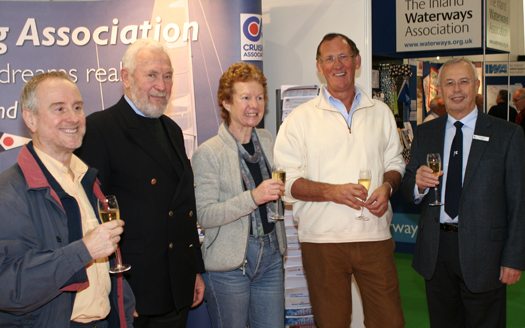
The 4,000th CA Member, Eric Roberts, is welcomed by fellow members (l to r) Paul Chandler, Patron Sir Robin Knox-Johnston, Rachel Chandler, and President Stuart Bradley.
What does Eric hope to gain from membership of the CA? First of all, he points out, his subscription has already more than paid for itself, earning him 5% discount on his annual berth at Gocek. He plans to use the members' website for passage planning information and also has ideas about using the Association's Crewing Service to help him look for crew. "And it will be great to see the burgee on other boats and go over and say hello".
Stuart Bradley, CA President, commented: "Welcoming Eric as the 4000th member is the climax of a very successful 12 months during which the Association increased its membership by a record 14%. We're seeing an increase in the number of UK-based sailors who keep their boats overseas, and also in members who don't have a boat and want to increase their experience by crewing for others."
"For many years the CA has been the cruising world's best kept secret. More people are now realising that we're like a world-wide local yacht club. Through electronic communication, our ever-expanding website, special interest Sections, and a network of Local Representatives in the popular cruising areas of the world, we can provide information and encouragement to cruising sailors wherever they live or cruise. We help to make members' dreams real."


























